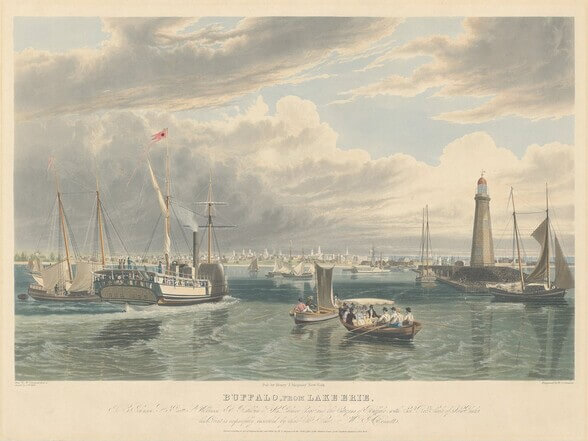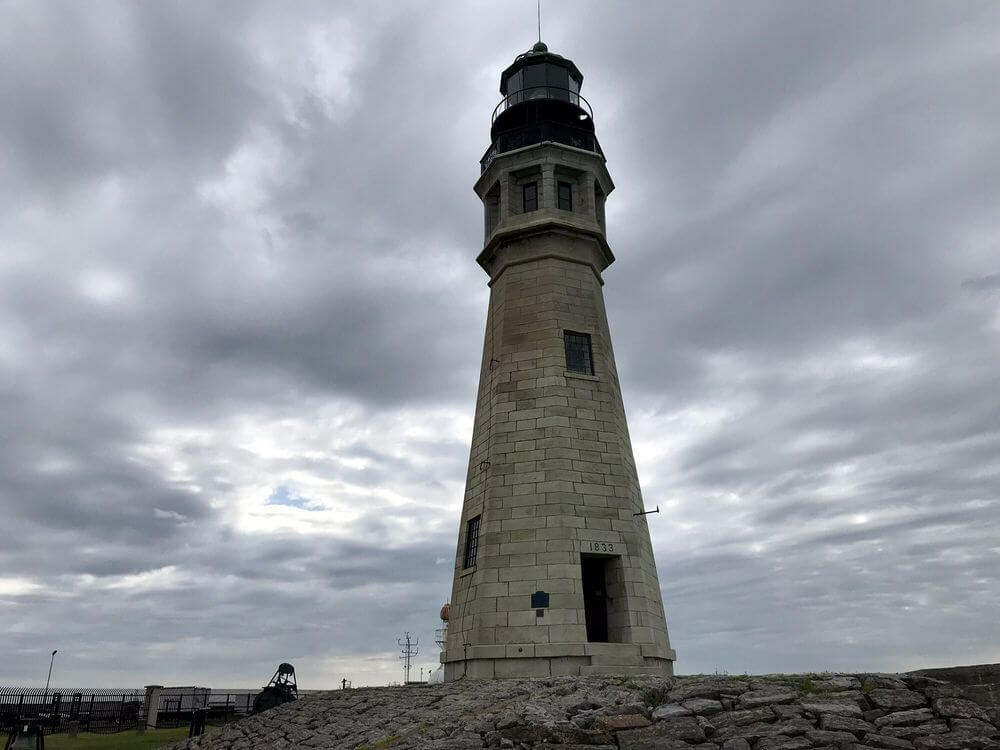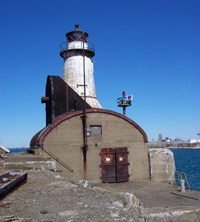Western New York is known for its many waterways, and the city of Buffalo sits right on Lake Erie, an essential location that gave it a crucial role in American history, especially after the construction of the Erie Canal.
You can still find relics today around Buffalo that demonstrate its importance as a port city in the colonial era and throughout the 19th and 20th centuries–including lighthouses, which were once used to guide ships into Buffalo when the city served as a booming center of industry and commerce. But even many locals may be unaware of these landmarks, many of which are designated as National Historic Places.

Buffalo’s First Lighthouse
According to LighthouseFriends.com, the history of lighthouses in Western New York can be traced back to the 1700s, when the French maintained temporary lights around Fort Niagara. At that time, Buffalo was just a small village within Native American territory. The first large lights on the Great Lakes were set up in Canada, but an increase in immigration and commerce eventually necessitated lights on the American side as well.
In 1805, the United States Congress declared the village of Buffalo a port of entry due to its prime location at the merging point of Lake Erie and the Niagara River. In 1811, the New York legislature developed a plan to acquire land for a lighthouse, but this was put on hold when the British burned Buffalo in the War of 1812.
Buffalo’s first lighthouse was completed in 1818, making it one of the first two American lighthouses on the Great Lakes, with the other constructed in Erie, PA. Buffalo Lighthouse served as a critical station for ships on the Great Lakes and even was the site of a major rescue of the Great Lakes’ only steamboat in 1821, according to LighthouseFriends.com.
Erie Canal Necessitates Another Lighthouse
As we’ve written before, the construction of the Erie Canal had a huge impact on the city of Buffalo and the U.S. economy as a whole. The Erie Canal is central to Buffalo’s history and was the major reason the city became a commercial and industrial powerhouse in the 1800s.
The canal opened in 1825, dramatically increasing Buffalo’s ship traffic and population. However, as a busy frontier town with a large percentage of immigrants, crime rates increased as well, and the government determined it necessary to build another lighthouse, pier and icebreaker that could help make the area safer and provide more light to the smoky industrial skies.

Buffalo’s second lighthouse was completed in 1833 and still stands today at the mouth of the Erie Canal, across from the Erie Marina Basin. Known as Buffalo Main Light, the 60-foot, octagonal limestone lighthouse was active until 1914.
According to the U.S. Coast Guard, Buffalo Main Light is the oldest structure still standing in its original location in the city of Buffalo. It was listed on the National Register of Historic Places in 1984. The lighthouse is currently the focal point of Lighthouse Point Park in the Outer Harbor, and the site offers informational and historic signs, artifact displays, scenic views and lighthouse tower tours by appointment, according to Discover Upstate New York.

The Buffalo Harbor North Entrance Light was located at the northern entrance of Buffalo’s Stony Point breakwater. The historic tower was deactivated in 1985 and listed on the National Register of Historic Places in 1983. It was relocated to sit on display near the Buffalo Main Light.

The Buffalo Harbor South Entrance Light is a lighthouse at the southern entrance of Stony Point, near the site of the former Lackawanna Steel (later Bethlehem Steel) mill. It became a pioneering fog signal and radio beacon station for the Great Lakes, according to BuffaloLight.org.
The historic South lighthouse was deactivated in 1993 and was listed on the National Register of Historic Places in 2007. It was replaced by the current South tower, which is a blinking red light on a pole on the breakwater adjacent to the original tower. It is owned by the U.S. Coast Guard and still serves as an active navigation aid.
Other Buffalo-Niagara Lighthouses
In addition to the historic Buffalo lighthouse, there are several others around Western New York that played key roles in our nation’s history.
Fort Niagara Lighthouse – Built in 1872, the Fort Niagara Lighthouse served as one of the few natural harbors on Lake Ontario and a pivotal portage route around Niagara Falls for early American settlers. It was constructed from a former lighthouse on the grounds of Old Fort Niagara and was used throughout most of the 20th century, becoming automated in 1983 and deactivated in 1993. According to Discover Update New York, this lighthouse is currently the only one on the Great Lakes with a high-definition camera for live streaming. You can watch the live stream on the Old Fort Niagara website and below (video to be inserted). If you see a ship passing on the webcam, you can click that ship on the map below the webcam to see both its origin and destination.
Olcott Harbor Lighthouse -The Olcott Harbor Lighthouse was erected in 1873 at the mouth of Lake Ontario and 18-Mile Creek. Prior to its construction, there were few, if any lighthouses, between the mouths of the Niagara and Genesee Rivers, a span of nearly 85 miles, according to US Lighthouses. The lighthouse was used until the 1930 and then moved to a local yacht club and dismantled in the 1960s. In 2003, without original blueprints or plans, the Olcott Lighthouse Society built a 27-foot tall replica lighthouse using old photographs as a guide.

 Fair Housing Notice
Fair Housing Notice 